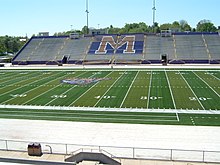
AstroTurf is an American subsidiary of SportGroup that produces artificial turf for playing surfaces in sports. The original AstroTurf product was a short-pile synthetic turf invented in 1965 by Monsanto. Since the early 2000s, AstroTurf has marketed taller pile systems that use infill materials to better replicate natural turf. In 2016, AstroTurf became a subsidiary of German-based SportGroup, a family of sports surfacing companies, which itself is owned by the investment firm Equistone Partners Europe.
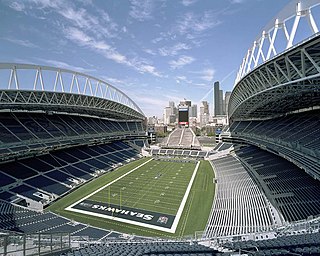
Lumen Field is a multi-purpose stadium in Seattle, Washington, United States. Located in the city's SoDo neighborhood, it is the home field for the Seattle Seahawks of the National Football League (NFL), Seattle Sounders FC of Major League Soccer (MLS), and Seattle Reign FC of the National Women's Soccer League (NWSL). Originally called Seahawks Stadium, it was renamed Qwest Field in June 2004 when telecommunications carrier Qwest acquired the naming rights. The stadium became known as CenturyLink Field following Qwest's June 2011 acquisition by CenturyLink and was nicknamed "The Clink" as a result; it received its current name in November 2020 with CenturyLink's rebrand to Lumen Technologies. It is a modern facility with views of the Downtown Seattle skyline and a seating capacity of 68,740 spectators for NFL games and 37,722 for most MLS matches. The complex also includes the Event Center which is home to the Washington Music Theater, a parking garage, and a public plaza. The venue hosts concerts, trade shows, and consumer shows along with sporting events. Located within a mile (1.6 km) of Downtown Seattle, the stadium is accessible by multiple freeways and forms of mass transit.

Gillette Stadium is a multi-purpose stadium located in the town of Foxborough, Massachusetts, which is 22 miles (35 km) southwest of downtown Boston, Massachusetts and 18 miles (29 km) northeast of Providence, Rhode Island. It serves as the home stadium and administrative offices for both the New England Patriots of the National Football League (NFL) and the New England Revolution of Major League Soccer (MLS). It opened in 2002, replacing the adjacent Foxboro Stadium. It also served as the home venue for the University of Massachusetts (UMass) Minutemen football team in 2012 and 2013, while on-campus Warren McGuirk Alumni Stadium underwent renovations; it continued to serve as a part-time home venue for higher attendance UMass games through 2018. Gillette Stadium's seating capacity is 64,628, including 5,876 club seats and 82 luxury suites.

Husky Stadium is an outdoor football stadium in the northwest United States, located on the campus of the University of Washington in Seattle, Washington. It has been home to the Washington Huskies of the Big Ten Conference since 1920, hosting their football games.

Paycor Stadium, previously known as Paul Brown Stadium, is an outdoor football stadium in Cincinnati, Ohio. It is the home venue of the Cincinnati Bengals of the National Football League (NFL) and opened on August 19, 2000.
Villanova Stadium is a 12,500 seat stadium located on the campus of Villanova University in Villanova, Pennsylvania, USA.
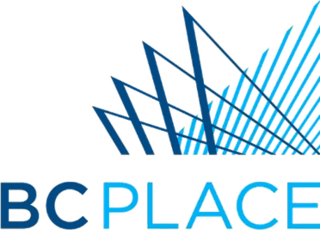
BC Place is a multi-purpose stadium in Vancouver, British Columbia, Canada. Located at the north side of False Creek, it is owned and operated by the BC Pavilion Corporation (PavCo), a crown corporation of the province.

Soccer-specific stadium is a term used mainly in the United States and Canada to refer to a sports stadium either purpose-built or fundamentally redesigned for soccer and whose primary function is to host soccer matches, as opposed to a multi-purpose stadium which is for a variety of sports. A soccer-specific stadium may host other sporting events and concerts, but the design and purpose of a soccer-specific stadium is primarily for soccer. Some facilities have a permanent stage at one end of the stadium used for staging concerts.

Artificial turf is a surface of synthetic fibers made to look like natural grass, used in sports arenas, residential lawns and commercial applications that traditionally use grass. It is much more durable than grass and easily maintained without irrigation or trimming, although periodic cleaning is required. Stadiums that are substantially covered and/or at high latitudes often use artificial turf, as they typically lack enough sunlight for photosynthesis and substitutes for solar radiation are prohibitively expensive and energy-intensive. Disadvantages include increased risk of injury especially when used in athletic competition, as well as health and environmental concerns about the petroleum and toxic chemicals used in its manufacture.
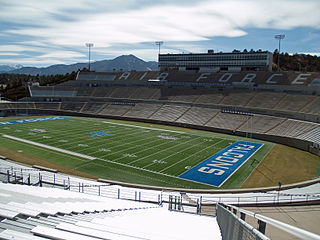
Falcon Stadium is an outdoor football stadium in the western United States, on the campus of the U.S. Air Force Academy near Colorado Springs, Colorado. It is the home field of the Air Force Falcons football and lacrosse teams of the Mountain West Conference, and also holds the academy's graduation ceremonies each spring.

Eck Stadium is a baseball stadium in Wichita, Kansas, United States. It is located on the south side of 21st Street between Hillside and Oliver on the campus of Wichita State University in northeast Wichita.

Crumb rubber is recycled rubber produced from automotive and truck scrap tires. During the recycling process, steel and tire cord (fluff) are removed, leaving tire rubber with a granular consistency. Continued processing with a granulator or cracker mill, possibly with the aid of cryogenics or by mechanical means, reduces the size of the particles further. The particles are sized and classified based on various criteria including color. The granulate is sized by passing through a screen, the size based on a dimension or mesh. Crumb rubber is often used in artificial turf as cushioning.

BMO Field is an outdoor stadium located at Exhibition Place in Toronto, Ontario, Canada. Constructed on the former Exhibition Stadium site and first opened in 2007, it is the home field of Toronto FC of Major League Soccer (MLS) and the Toronto Argonauts of the Canadian Football League (CFL). BMO Field is owned by the City of Toronto and managed by Maple Leaf Sports & Entertainment, which owns both Toronto FC and the Argonauts. The stadium's naming rights are held by the Bank of Montreal, which is commonly branded as "BMO".

The Kamuzu Stadium is a multi-purpose stadium in Blantyre, Malawi. It is currently used mostly for football matches. The stadium holds 65,000 people. This can be limited for safety reasons. Big Bullets and Be Forward Wanderers are tenants.

Starfire Sports is a multi-purpose stadium and sporting facility in Tukwila, Washington, United States. It is located on the banks of the Green River, just south of Seattle. The stadium is operated by the nonprofit corporation Starfire Sports and is home to several soccer and rugby teams. At the time of its opening, CEO Chris Slatt claimed it was "the largest synthetic-turf soccer complex in the U.S."

Saputo Stadium is a soccer-specific stadium at Olympic Park in the borough of Mercier–Hochelaga-Maisonneuve in Montreal, Quebec, Canada. The stadium opened on May 21, 2008, and is the current home of CF Montréal. The stadium is built on the former practice track and field site on the grounds of the 1976 Summer Olympics, while the stadium's east side has a view of Olympic Stadium's inclined tower. It has a capacity of 19,619, making it the second-largest soccer-specific stadium in Canada, after BMO Field in Toronto.

A multi-purpose stadium is a type of stadium designed to be easily used for multiple types of events. While any stadium could potentially host more than one type of sport or event, this concept usually refers to a specific design philosophy that stresses multifunctionality over specificity. It is used most commonly in Canada and the United States, where the two most popular outdoor team sports—Canadian football or American football and baseball—require radically different facilities. Football uses a rectangular field, while baseball is played on a diamond with a large outfield. Since Canadian football fields are larger than American ones, the design specifications for Canadian facilities are somewhat less demanding. The particular design to accommodate both is usually an oval, although some later designs use an octorad. While building stadiums in this way means that sports teams and governments can share costs, it also presents some challenges.
Poly-Turf was a brand of artificial turf in the early 1970s, manufactured by American Biltrite of Wellesley, Massachusetts. It was the first specifically designed for American football, with a patented layered structure which included a "shock pad" between the artificial grass and the asphalt sub-surface. It used polypropylene for its artificial grass blades, rather than the nylon used in AstroTurf and 3M's Tartan Turf.

Donnell Stadium, which was built in 1927 at a cost of $150,000, continues to serve as one of the stadiums of Ohio.
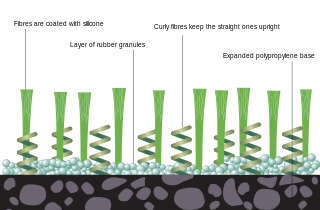
Artificial turf is surface of synthetic fibers resembling natural grass. It is widely used for sports fields for being more hard-wearing and resistant than natural surfaces. Most use infills of crumb rubber from recycled tires; this use is controversial because of concerns that the tires contain carcinogens, though research into the issue is ongoing.
